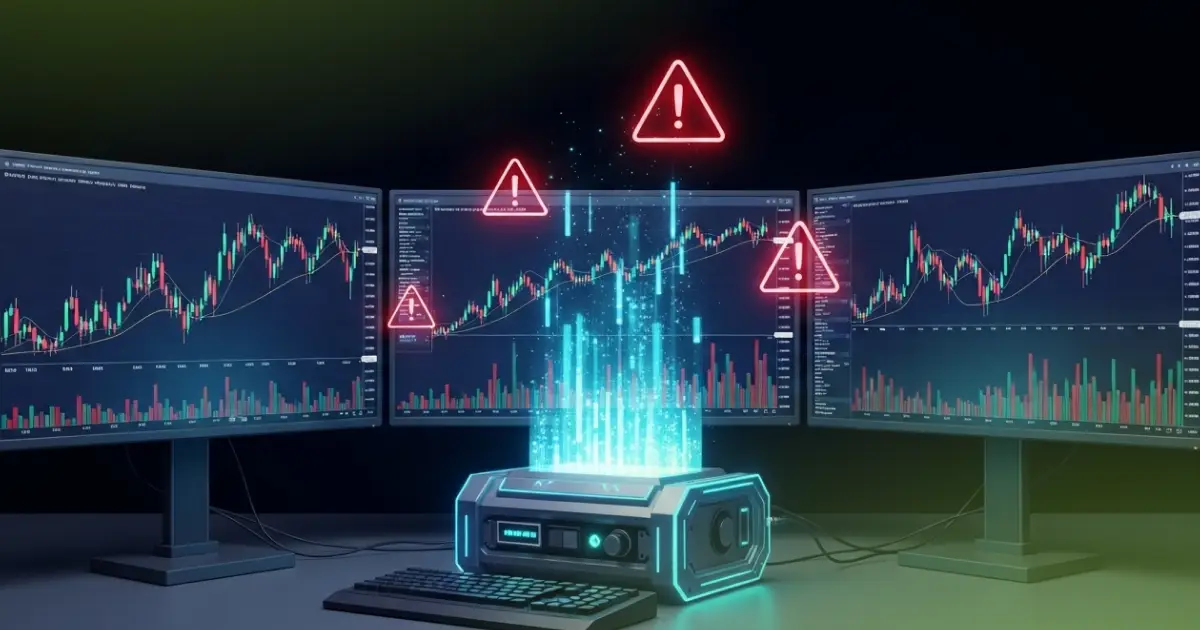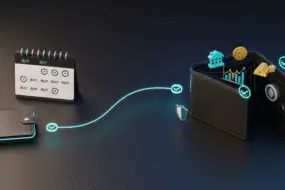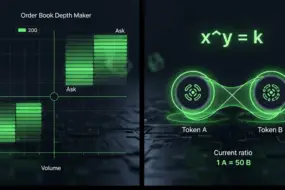
Imagine you’ve just launched your first AI crypto trading bot, expecting it to scan market data, analyze trends, and execute trades with superhuman speed. It’s running 24/7, across multiple exchanges, and seems like the perfect replacement for emotional, error-prone manual trading.
But then – boom. Your portfolio dips fast. You ask yourself: “If these automated trading bots are so smart, why am I losing money?”
Welcome to the hidden world of bot trading risks, where even the most sophisticated AI trading bots can misfire badly. From slippage during volatile swings to overfitting on irrelevant past data, we’ll uncover the silent killers of automated crypto strategies.
Ready to trade smarter, not harder? Then you’ll want to read this through to the very last line.
Key Takeaways
Slippage can destroy profitability in volatile or illiquid markets – use limit orders and risk controls.
Overfitting makes bots fragile – train with adaptive, real-time data.
Risk management isn’t optional – it’s the core of long-term survival.
The Alluring Promise of Automated Trading

“Never miss a profitable trade again” – that’s the charming promise of cryptocurrency trading bots, which have tripled in popularity in parallel with growing crypto markets. From simple grid trading bots to sophisticated AI-driven trading bots, these automated systems execute trades based on pre-defined parameters without human intervention.
The best crypto trading bots can process market data at speeds no human trader could match, but what happens when these digital trading assistants encounter situations they weren’t programmed to handle? How do you avoid these pitfalls? What separates a profitable AI trading bot from one that burns through your capital? Let’s explore the hidden dangers of bot trading.
Slippage: The Silent Account Killer

Let’s start with slippage – the gap between the price you expect and the price your trading bot actually gets. In the crypto industry, especially in futures trading or low-liquidity coins, this can cost you more than you think.
Even the best crypto trading bot can’t escape it entirely. Bots react in milliseconds, yes – but so do other bots, especially market makers and arbitrage bots hunting for price inefficiencies.
Slippage increases during:
Sudden news events
Low-liquidity conditions
High-volatility market swings
Without effective risk management, bots can end up buying high and selling low, destroying your account equity trade by trade.
Tip: Use limit orders, test bots in paper trading environments, and choose platforms with robust security measures and low trading fees to minimize losses.
Overfitting: When “Smart” Bots Learn Too Much

Imagine training an AI powered crypto trading bot on years of historical data. It starts to predict patterns. Excited, you launch it live.
Only it collapses when real-time data shifts. Why? Overfitting.
This is when machine learning models “memorize” irrelevant past data, failing to adapt to real market conditions. It’s like studying only one specific exam paper and expecting the same questions on test day.
Overfitting is the Achilles’ heel of AI bots. They can:
Misread market sentiment
Fail to adapt to shifting market dynamics
Lock into fixed rules that no longer apply
Remember, AI doesn’t mean automatic profit; it means intelligent adaptation.
Tip: Regularly test strategies, train bots with real-time market data, and avoid datasets that no longer reflect today’s financial markets.
The “Set and Forget” Fallacy

Have you fallen for the common misconception that trading bots are “set and forget” solutions? Many traders implement their automated trading systems, then step away completely, expecting the algorithms to handle everything perfectly. This approach can lead to disaster.
Here’s a dirty secret: the best AI trading bot is only as good as the person who deploys it. Market conditions change, volatility fluctuates, and trading strategies that worked brilliantly last month might become obsolete today. Without regular monitoring and adjustment, even the best crypto trading bot can quickly become ineffective or, worse, actively harmful to your portfolio.
Bots need tuning. They don’t read headlines, feel FUD, or watch market manipulation unfold in real-time.
Your role?
Adjust position sizing
Monitor risk exposure
Interpret market sentiment
Decide when to halt trading
Tip: Stay involved. Use smart trading terminals to manage bots across multiple exchanges and centralize your view of all trading processes.
Strategy Mismatch: When Bots Use the Wrong Playbook

Different bots, different brain:
Grid bots thrive in sideways markets but collapse in market trends.
Arbitrage bots rely on price differences between exchanges, but those gaps are narrowing fast.
Swing trading bots can lag in fast-paced momentum rallies.
The real trap is using the wrong trading strategies for the wrong market conditions. Bots don’t think outside the rules. If your trading algorithms say “buy on dip,” and the market just keeps dipping, you’re left risking real money on a strategy that no longer works.
Tip: Rotate strategies. Use multiple bots across different market dynamics. Employ key metrics to monitor and halt underperforming bots in live markets.
The Boom of AI-Powered Trading Bots

The newest generation of trading bots incorporates artificial intelligence and machine learning to adapt to shifting market dynamics. Unlike traditional bots that follow fixed rules, these AI trading bots can theoretically learn from their mistakes and evolve their strategies.
But does this advanced technology eliminate the risks? Not quite. AI-driven trading bots still face significant challenges:
Data Quality Issues: Machine learning algorithms are only as good as the data they train on. Poor or limited historical data can lead to faulty decision-making.
Black Box Problem: Many AI systems operate as “black boxes,” making decisions through processes that even their creators can’t fully explain. This lack of transparency makes troubleshooting nearly impossible when things go wrong.
Adaptation Lag: Even the most sophisticated AI systems need time to adapt to fundamental market changes. During this adaptation period, losses can accumulate rapidly.
One crypto trader described his experience: “My AI bot performed brilliantly for three months straight. Then market sentiment shifted dramatically after a regulatory announcement, and it lost 40% in two days before I could intervene.”
Beyond the Algorithm: Overlooked Technical Risks
Trading efficiency isn’t just about having smart algorithms – it’s also about technical execution. Here are some commonly overlooked technical pitfalls that can destroy even well-designed trading strategies:
1. API Failures and Exchange Downtimes
Your bot is only as reliable as the exchanges it trades on. During peak volatility, precisely when you need your bot most, exchanges frequently experience outages or API throttling. This can leave your bot unable to execute critical trades or, worse, with partially completed orders that expose you to unexpected risk.
2. Security Vulnerabilities
When you connect your trading bot to exchanges through API keys, you create potential security vulnerabilities. Without robust security measures like IP restrictions and withdrawal limitations, compromised API credentials could give hackers direct access to your funds.
3. Multiple Exchange Complications
Many sophisticated traders deploy bots across multiple exchanges to capitalize on arbitrage opportunities or access different trading pairs. However, this complexity introduces synchronization challenges and increases the potential for errors, particularly when bots need to coordinate activities across platforms with different latencies and fee structures.
Neglecting True Risk Management
The biggest myth in AI crypto trading bots is that automation means safety. Wrong.
Without clear risk management protocols, bots can spiral out of control, especially in volatile markets. Unchecked trading efficiency often leads to leveraged blowouts or misaligned portfolios.
Ask yourself:
Do I have a stop-loss in place?
Does my bot consider technical indicators and market sentiment?
Am I limiting risk exposure per trade?
If the answer’s no, you’re gambling – just with a fancier tool.
How to Avoid the Common Pitfalls?
Ready to overcome these hazards more effectively? Here’s your roadmap to safer bot trading:
Start with Paper Trading
Before risking real money, test your bots extensively in paper trading environments. This allows you to identify potential issues without financial consequences. Most reputable platforms offer paper trading options specifically for this purpose.
Implement Robust Risk Controls
Every trading bot should have built-in safeguards:
Stop-Loss Protection: Automatic trade closure when losses reach predetermined thresholds
Position Sizing Limits: Restrictions on how much capital can be allocated to single trades
Daily Loss Caps: Automatic trading halts when daily losses exceed acceptable levels
Regular Performance Reviews
Successful bot traders review key metrics at least weekly, including:
Win/loss ratios
Average profit per trade vs. average loss
Performance across different market conditions
Slippage metrics
Diversify Bot Strategies
Never rely on a single bot strategy. Different approaches perform better in different market conditions. Consider implementing multiple bots with varying strategies:
Trend-following bots for directional markets
Range-trading bots for sideways markets
Arbitrage bots for exploiting exchange price differences
Stay Educated on Market Fundamentals
The most successful bot traders maintain deep knowledge of market fundamentals. Technical indicators alone can’t predict how markets will react to major news events, regulatory changes, or macroeconomic shifts. By staying informed, you can temporarily reverse your bots when extraordinary circumstances arise – something no algorithm can fully anticipate.
Final Thought: Are You Smarter Than Your Bot?
Trading bots are powerful. AI-driven trading bots are even smarter. But they’re not invincible. They don’t adapt unless you train them to. They don’t manage risk unless you build in the rules. They don’t pause during panic unless you tell them to.
The path from slippage to overfitting is littered with broken strategies and overconfident traders. Don’t be one of them. Instead, become the kind of trader who knows the difference between hype and reality, between automation and intelligence.
Want to survive the crypto jungle? Then learn to think like a bot and trade smarter than one.
FAQs
What is market making in crypto trading bots?
Market making bots place simultaneous buy and sell orders to profit from price spreads, boosting liquidity. They require precise timing and strong risk controls, especially in volatile markets.
How does algorithmic trading differ from manual trading?
Algorithmic trading uses code or AI to auto-execute trades based on market data. Unlike manual trading, bots operate without emotion and react instantly, but still need human oversight to adapt to market shifts.
Can bots use various trading strategies at once?
Yes. Advanced bots can run multiple strategies – like grid, arbitrage, or trend-following – across different market conditions. Diversification helps reduce risk, but performance still requires regular reviews.









